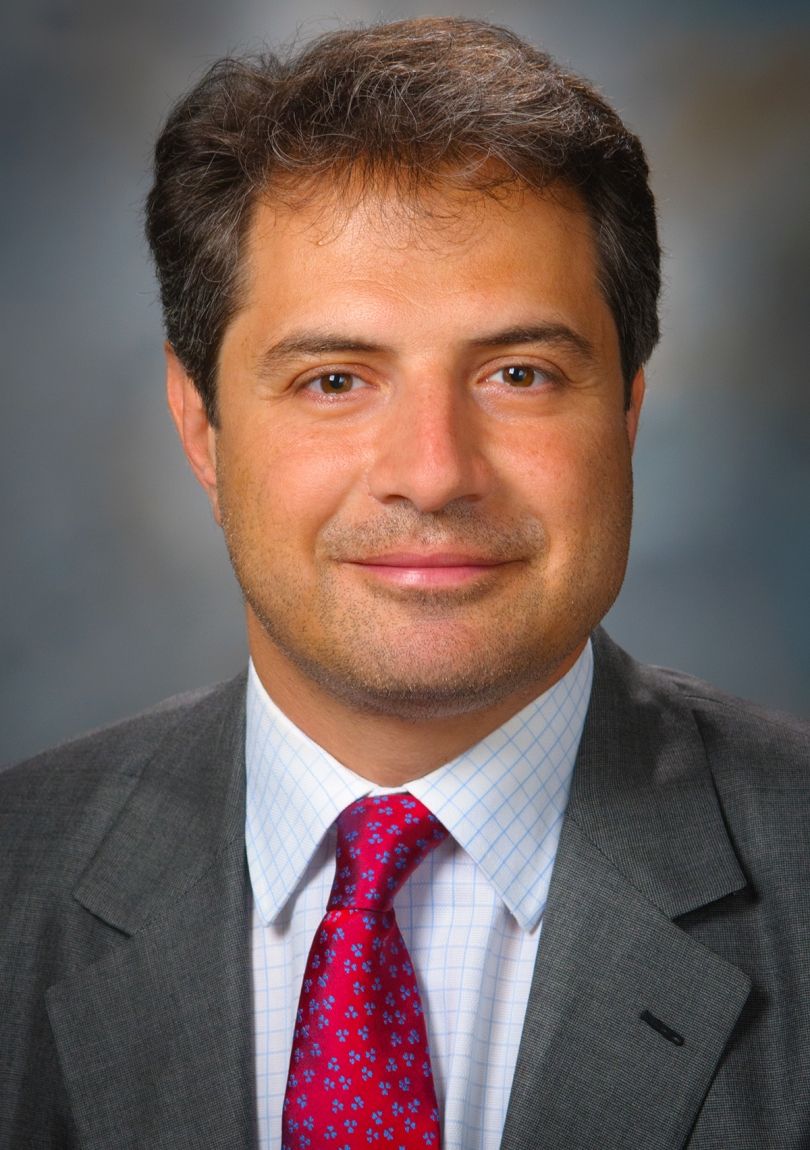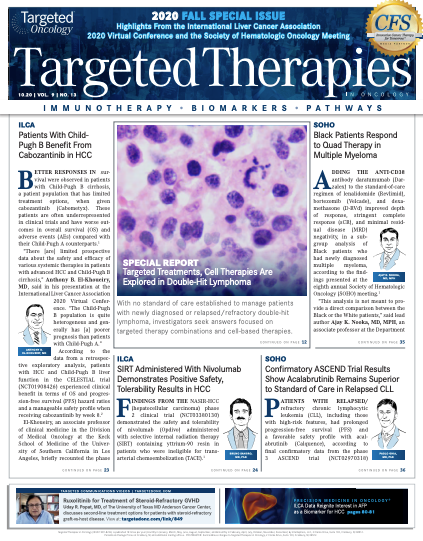Targeted Agents Induce Significant Efficacy in Older, Frail Patients With ALL
On the treatment of adult patients with acute lymphoblastic leukemia, long-term cure rates in elderly populations, or those older than 55 to 60 years of age, are approximately 15% to 20% and represent a clinically unmet need in this hematologic cancer.
Elias Jabbour, MD

On the treatment of adult patients with acute lymphoblastic leukemia (ALL), long-term cure rates in elderly populations, or those older than 55 to 60 years of age, are approximately 15% to 20% and represent a clinically unmet need in this hematologic cancer.1
“These patients usually have poorer outcomes. The reasons are two-fold. Number one, they have more advanced disease and worse biology. They [tend to] have all the worst features, [such as] hyperdiploidy.” Elias Jabbour, MD, said in an interview prior to the eighth annual Society of Hematologic Oncology (SOHO) meeting. “Number two, they already have comorbidities and limited organ function, meaning that even if you can put them on a regimen, these patients are prone to complications.”
In an analysis published in Blood based on entries in the National Cancer Institute’s Surveillance, Epidemiology, and End Results (SEER) database, a median overall survival of 4 months (95% CI, 3-5) was assessed from 1675 adults with ALL who were 60 years or older between 1980 and 2011. Rates of OS at 3 years was 12.8% (95% CI, 11.2%-14.5%), with a median follow-up of 26 months among survivors.2
“These patients are very frail,” Jabbour, who is a professor in the Department of Leukemia at The University of Texas MD Anderson Cancer Center in Houston, said. “ALL is a curable disease. The outcomes [for these patients] are mainly driven by poor biology.”
Jabbour conducted a discussion titled, “How I Treat the Older Adult with B-ALL” as well as served as session chair of “Meet the Professor Session XII: ALL” during the society’s annual meeting.
Intensive Chemotherapy in ALL
Investigators treating patients with ALL have attempted to unravel some of the reasons behind the causes of mortality in this population, revealing that myelosuppression-suppression-associated events were a significant cause of death in patients achieving complete responses (CR) with intensive chemotherapy regimens.3
One such trial explored the use of the hyper-CVAD regimen—or hyperfractionated cyclophosphamide, vincristine, doxorubicin, and dexamethasone—alternated with methotrexate and cytarabine followed by maintenance with 6-mercaptopurine, vincristine, methotrexate, and prednisone in patients 60 years of age or older (n = 122) versus patients who were under the age of 60 years (n = 409). Additionally, 34 patients who were 60 years of age or older were administered a less-intensive chemotherapy regimen as a comparator. Findings showed that CR rates in the older population receiving hyper-CVAD was 84% versus 92% in the younger population (P < .001). The older patients who received the less-intensive regimen experienced CRs at a rate of 59%.3
Induction mortality rates were 10%, 12%, and 2% in older patients receiving hyper-CVAD, older patients receiving other regimens, and younger patients receiving hyper-CVAD, respectively. Corresponding rates of death in CR were 34%, 15%, and 7% (P < .001), respectively, with investigators noting most deaths attributable to infections.3
Out of 102 older patients achieving CR with hyper-CVAD, 76 (75%) experienced treatment failure due to death in 35 and recurrence in 41 patients. Twenty-two deaths (63%) were caused by infections. These results led investigators to conclude that, while effective, low-intensity agents/regimens for this patient population may further improve results.3
Targeted Agents Reduce Chemotherapy Intensity, Improve Survival
One attractive therapeutic target in precursor B-cell ALL is CD19, which is expressed in the majority of patients with the disease. Blinatumomab (Blincyto) is an anti-CD19 bispecific antibody that is approved for the treatment of relapsed/refractory B-cell precursor acute lymphoblastic leukemia (ALL) in adults and children.4
The phase 2 SWOG 1318 trial (NCT02143414) examined patients 65 years of age or older with Philadelphia chromosome (Ph)–negative ALL treated with blinatumomab plus prednisone, vincristine, 6-mercaptopurine, methotrexate (POMP). The CR and 1-year OS rates were 66% and 65%, respectively.5
Approved in 2017 for the treatment of patients with relapsed/refractory B-cell precursor ALL, inotuzumab ozogamicin (Besponsa) is a humanized monoclonal antibody against the surface glycoprotein CD22 expressed in most patients with B-cell ALL. 6,7 Approval for this indication was based on the phase 3 INO-VATE trial (NCT01564784), demonstrating that the CD22 antibody induced complete remission in 35.8% of patients versus 17.4% in those receiving chemotherapy.6
A study of older patients with Ph-negative ALL was performed to analyze the efficacy of inotuzumab ozogamicin in combination with low-dose chemotherapy, with or without blinatumomab, versus standard therapy.8
When asked about the rationale for combining the inotuzumab ozogamicin and blinatumomab, Jabbour commented on their different mechanisms of action. “One may say, why are you using these targets? It’s because CD19 and CD22 are different targets and not overlapping. We hope to have synergistic activity and better outcomes [with the use of both agents],” he said.
In 58 patients who were between the ages of 60 and 81 years, the CR rate was 98% with low rates of death in complete remission (5%) and no reported early deaths. The 3-year OS rate was 54%.8
“We are comfortable that this regimen can become a new standard of care…for older patients with ALL,” Jabbour said, adding that “there is room to improve on this regimen because despite the improvement [in efficacy], we are still losing patients in CR. Mainly these patients are 70 years and older.”
Jabbour suggested that chemotherapy can be further reduced or eliminated altogether to allow clinicians to rely solely on targeted therapy. “These regimens are highly tolerated and lead to improvements in outcomes,” he said. “We are looking for other [study] groups to have a complimentary trial to establish its use in the older population.”
One such study that is currently ongoing is the phase 2 Alliance A041703 trial (NCT03739814), examining the combination of inotuzumab ozogamicin and blinatumomab in newly diagnosed older adult patients or those with relapsed/refractory B-cell ALL.9
Before his presentation at the conference, Jabbour said: “my take-away message is that we have effective therapeutics for ALL in the frontline, in the older population in particular,” he said. “Sometimes, [though older patients] are not treated, they are sent to hospice.” He stressed the importance of sending these patients to a clinical trial to improve survival outcomes.
References:
1. Rafei H, Kantarjian HM, Jabbour EJ. Targeted therapy paves the way for the cure of acute lymphoblastic leukaemia. Br J Haematol. 2020;188(2):207- 223. doi:10.1111/bjh.16207
2. Geyer MB, Hsu M, Devlin SM, Tallman MS, Douer D, Park JH. Overall survival among older US adults with ALL remains low despite modest improvement since 1980: SEER analysis. Blood. 2017;129(13):1878-1881. doi:10.1182/blood-2016-11-749507
3. O’Brien S, Thomas DA, Ravandi F, Faderl S, Pierce S, Kantarjian H. Results of the hyperfractionated cyclophosphamide, vincristine, doxorubicin, and dexamethasone regimen in elderly patients with acute lymphocytic leukemia. Cancer. 2008;113(8):2097-2101. doi:10.1002/cncr.23819
4. FDA grants regular approval to blinatumomab and expands indication to include Philadelphia chromosome-positive B cell. FDA. July 11, 2017. Accessed August 6, 2020. https://bit.ly/3gBg6ML
5. Advani A, Moseley A, O’Dwyer K, et al. Results of SWOG 1318: a phase 2 trial of blinatumomab followed by POMP maintenance in elderly patients with newly diagnosed Philadelphia chromosome negative B-cell acute lymphoblastic leukemia. Blood. 2018;132(suppl 1):33. doi:10.1182/ blood-2018-99-111992
6. FDA approves inotuzumab ozogamicin for relapsed or refractory B-cell precursor ALL. FDA. April 17, 2017. Accessed August 6, 2020. https://bit. ly/2DkQZzs
7. Kantarjian HM, DeAngelo DJ, Stelljes M, et al. Inotuzumab Ozogamicin versus Standard Therapy for Acute Lymphoblastic Leukemia. N Engl J Med. 2016;375(8):740-753. doi:10.1056/NEJMoa1509277
8. Jabbour EJ, Sasaki K, Ravandi F, et al. Inotuzumab ozogamicin in combination with low-intensity chemotherapy (mini-HCVD) with or without blinatumomab versus standard intensive chemotherapy (HCVAD) as frontline therapy for older patients with Philadelphia chromosome-negative acute lymphoblastic leukemia: A propensity score analysis. Cancer. 2019;125(15):2579-2586. doi:10.1002/cncr.32139
9. Alliance trial to seek better prognosis for patients with acute lymphoblastic leukemia. Alliance for Clinical Trials in Oncology. March 2019. Accessed August 6, 2020. https://bit.ly/2DsSBH9

Survivorship Care Promotes Evidence-Based Approaches for Quality of Life and Beyond
March 21st 2025Frank J. Penedo, PhD, explains the challenges of survivorship care for patients with cancer and how he implements programs to support patients’ emotional, physical, and practical needs.
Read More